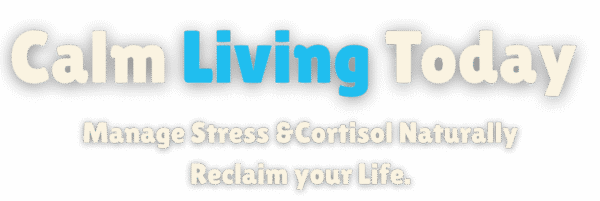How to Recover from Burnout and Lower Cortisol Naturally by Robert
High cortisol levels nearly cost me everything. As a church leader juggling endless responsibilities, traveling nationwide, resolving conflicts, guiding the grieving, and caring for the dying, and also a family with 4 young boys. I ignored the signs my body was breaking down. What began as passion turned into chronic stress, and eventually, full-blown burnout. My energy vanished, sleep became elusive, and anxiety crept in like a shadow. In this article, I’ll share how prolonged exposure to high cortisol levels silently drove me to the edge, and how I slowly walked the path back to balance, healing, and wholeness. If you’re feeling overwhelmed, exhausted, or emotionally drained, you’re not alone—and there is a way through.
There was a time when I thought I could carry the weight of the world, juggle work and family responsibilities without taking time for self care, boy was I wrong. For over ten years, I served as a church minister, an incredibly demanding role. When I wasn’t traveling accross the country running workshops and seminars, I was resolving church member squabbles, conducting weddings and funerals, and the most heart breaking of all, comforting church members and their families as their loved one’s lay on their deathbed. The whole time I was quietly breaking down, but I didn’t realise this until it was too late.
Fatigue clung to me like a heavy fog, my sleep became scarce and I would often wake up tired. I snapped at my loved ones, I was anxious, irritable. Like a thunderstorm the dark clouds of depression began rolling in. Something was wrong, but I couldn’t put my finger on it. The silent culprit was consistently high cortisol levels that eventually led to burnout.
This is the story of how consistently high cortisol levels silently led me to burnout, and how I walked the long road back using natural tools that changed my life.
What Is Cortisol and Why It Matters
Cortisol is a hormone produced by your adrenal glands. It’s your body’s natural alarm system that is released in response to stress. In small bursts, cortisol helps you stay alert, manage blood sugar, reduce inflammation, and regulate your sleep-wake cycle.
But when cortisol stays elevated for too long, due to chronic stress, poor sleep, or overwork, it becomes toxic, this can lead to burnout.
High cortisol disrupts nearly every system in the body
How High Cortisol Levels Showed Up In My Life
Looking back, the signs were all there. I just didn’t know how to read them at the time.
High cortisol levels affected me in the following ways:
- I couldn’t fall asleep
- I felt emotionally flat
- My digestion was off
- I gained stubborn belly fat
I was basically living in survival mode.
The Overdrawn Account
This slow burn eventually led to a crash. My body forced me to stop and I was no longer able to function. I withdrew and lost the passion and desire for the things that I once enjoyed, depression became like a black hole that swallowed light hope and energy.
It’s like my energy, time and emotional reserves were all sitting in a personal bank account. Every time I helped someone, said “yes” when I wanted to say “no,” skip a meal, cut back on sleep, or silence my own needs for the sake of others, I made a withdrawal.
At first, the account seems full. I told myself, “I’ve got this.” But I kept giving and giving.
I didn’t make deposits, I didn’t rest, or fuel my body with nourishing foods. I lost my sense of boundaries.
Eventually, the account balance hits zero, but you keep swiping. Now you’re in overdraft. You start borrowing against your health and relationships. You take out loans in the form of caffeine, adrenaline, and sheer willpower.
Until one day…
The account closes.
I hit emotional bankruptcy.
There’s nothing left to give, not even to myself.
Consistently high cortisol levels led to my gradual descent into burnout, I neglected:
- Time with my family, my four boys
- needed me, but I was always “on call”
- Restful sleep, I was always thinking, planning, worrying
- Good food, I ate what was quick, not what was nourishing
- Myself, I held myself to impossible standards and forgot to breathe
Eventually, everything caught up with me. I broke down. I couldn’t work. Depression and anxiety filled the silence that followed.

The Slow Journey Back
The Scraggly Plant
I was once given a plant that, due to my neglect, ended up looking like it had been through a natural disaster, sunlight starved, badly dehydrated, I thought it was dead. Honestly, I was about to throw it out, but the plant lover in me just couldn’t do it.
So, I did what any responsible (and slightly guilty) plant owner would do, a little watering here, some sunlight there.
Then something miraculous happened. One day, I noticed a tiny green shoot poking up. It’s alive! I’d like to say it was my expert care, but honestly, it was mostly that little plants will survive. Now it’s beautiful and thriving today.
The moral of the story? That scrappy plant taught me a valuable lesson: sometimes all it takes is a little patience, some consistent care, and maybe a bit of stubborn hope to bring life back, even when you think it could be too late.
The path to recovery isn’t an easy one, but like the plant, if you don’t give up you will eventually reach your goal, this is what I did to naturally lower my cortisol levels:
- I forced myself to move, even when I didn’t feel like it. Often the moments when you don’t feel like moving are when you need to move the most. A short walk in the sun became a powerful therapy session I desperately needed.
- I discovered strength training. I started with some dumbbells, now I’m constantly chasing my next personal record. Reconnecting to my body helped reconnect me to life.
- I improved my nutrition, I prioritised eating mostly healthy foods, with a little room to indulge. Eating well gave me the energy I’d lost.
- I started practicing bonsai, this tiny tree became a big metaphor for healing. It taught me patience, presence, and that beauty can grow slowly.
And most of all—I made my four boys my priority. They became my reason to rise.
How to Lower Cortisol Naturally
Don’t get me wrong, I believe prescribed medication has its place, but what saved me wasn’t medication. It was a holistic, consistent approach grounded in self-respect and healing. I discovered that true recovery begins when we calm the mind, restore the body, and reclaim our lives.
Calm the Mind
- Reframing my Mind: I planted new positive seeds of thought, and weeded out the negative ones, I allowed the positive thoughts to grow and take root, they create a new and more positive outlook on life.
- Nature Time: Just sitting with my bonsai trees, walks in nature, or listening to birds worked wonders.
- Digital Boundaries: I turned off notifications. I reclaimed quiet moments.
Restore the Body
- Nutrition: I focused on whole foods, cut down on caffeine and sugar, and added calming adaptogens like green tea and magnesium glycinate.
- Strength Training: This was key. Focused, regular resistance training brought back energy and mental clarity.
- Sleep Hygiene: No screens before bed, cooler room, and consistent sleep times helped retrain my body clock.
Reclaim Your Life
- Boundaries: I stopped saying yes to everything. I began honouring my time and energy.
- Family First: I invested in time with my four sons. They became my reason to heal.
- Bonsai Hobby: Tending to bonsai brought mindfulness, patience, and a deep sense of calm back into my life.
Here are a few powerful natural methods supported by science:
- Ashwagandha: Shown to reduce cortisol and improve resilience to stress.
- Rhodiola Rosea: Helps reduce fatigue and improve mood.
- Magnesium: Crucial for calming the nervous system.
- L-Theanine (from green tea): Promotes relaxation without drowsiness.
- Cold Exposure & Sauna: Help reset the stress response and build resilience.
Walk the Path to Healing
Burnout isn’t weakness. It’s a sign your body is crying out for change. If you’re living in a constant state of stress, please know: there is a path forward.
Fast forward to the present day, I have been frontline worker in the homelessness sector for almost 10 years, I know a thing or two about what it takes to be physically and mentally health in one of the most demanding sectors.
Thank you for allowing me to share my story with you, and I hope I can be a source of encouragement to others who may also be struggling with high workloads.
It takes courage to rest. It takes strength to choose healing. But I promise, if you walk the path of calm, restore your body, and reclaim your life, you’ll feel whole again.
Until next time, walk the path, and walk it gently.
FAQ About High Cortisol Levels
What are the signs of high cortisol?
Fatigue, insomnia, weight gain, anxiety, brain fog, and digestive issues are common.
How long does it take to recover from high cortisol levels?
With natural methods, many people begin to feel better in 2–3 months. Full recovery may take 6–12 months, depending on severity.
Can you really reduce cortisol naturally?
Yes. With the right habits—nutrition, stress management, and lifestyle—you can significantly lower cortisol.
Do I need to take supplements?
Not always. Start with lifestyle changes. Supplements like magnesium or adaptogens can support, not replace, foundational habits.
Disclaimer: This content is for informational purposes only and does not substitute professional medical or psychological advice. Please consult a qualified healthcare provider for personalized guidance.




